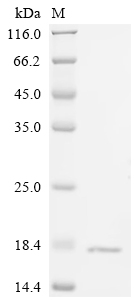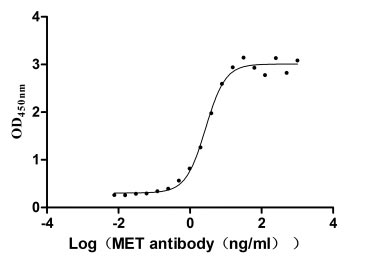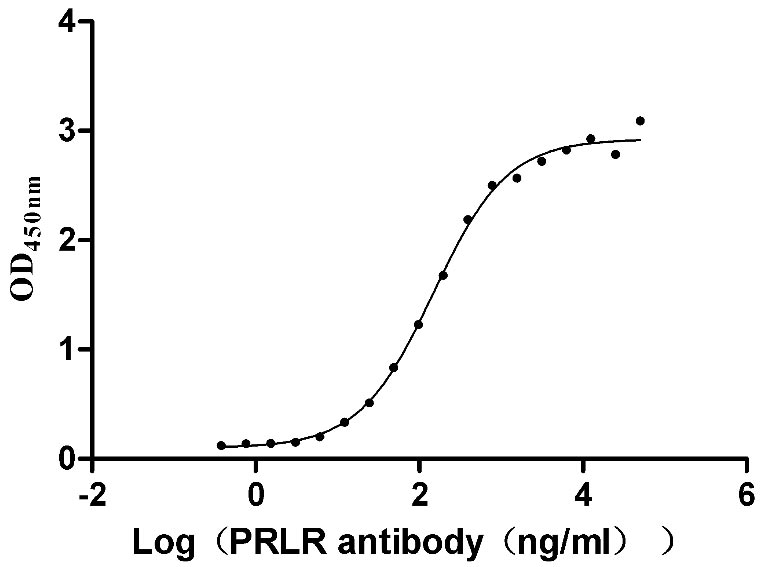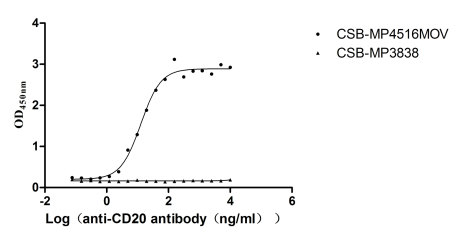Recombinant Human Fatty acid-binding protein, intestinal (FABP2)
In Stock-
中文名稱:人FABP2重組蛋白
-
貨號:CSB-YP007942HU
-
規格:¥1656
-
圖片:
-
其他:
產品詳情
-
純度:Greater than 95% as determined by SDS-PAGE.
-
生物活性:Not Test
-
基因名:
-
Uniprot No.:
-
別名:Fatty acid-binding protein 2;Intestinal-type fatty acid-binding protein;I-FABP
-
種屬:Homo sapiens (Human)
-
蛋白長度:Full Length of Mature Protein
-
來源:Yeast
-
分子量:17.7 kDa
-
表達區域:2-132aa
-
氨基酸序列AFDSTWKVDRSENYDKFMEKMGVNIVKRKLAAHDNLKLTITQEGNKFTVKESSAFRNIEVVFELGVTFNYNLADGTELRGTWSLEGNKLIGKFKRTDNGNELNTVREIIGDELVQTYVYEGVEAKRIFKKD
Note: The complete sequence may include tag sequence, target protein sequence, linker sequence and extra sequence that is translated with the protein sequence for the purpose(s) of secretion, stability, solubility, etc.
If the exact amino acid sequence of this recombinant protein is critical to your application, please explicitly request the full and complete sequence of this protein before ordering. -
蛋白標簽:N-terminal 10xHis-tagged
-
產品提供形式:Liquid or Lyophilized powder
Note: We will preferentially ship the format that we have in stock, however, if you have any special requirement for the format, please remark your requirement when placing the order, we will prepare according to your demand. -
緩沖液:If the delivery form is liquid, the default storage buffer is Tris/PBS-based buffer, 5%-50% glycerol. If the delivery form is lyophilized powder, the buffer before lyophilization is Tris/PBS-based buffer, 6% Trehalose.
-
復溶:We recommend that this vial be briefly centrifuged prior to opening to bring the contents to the bottom. Please reconstitute protein in deionized sterile water to a concentration of 0.1-1.0 mg/mL.We recommend to add 5-50% of glycerol (final concentration) and aliquot for long-term storage at -20℃/-80℃. Our default final concentration of glycerol is 50%. Customers could use it as reference.
-
儲存條件:Store at -20°C/-80°C upon receipt, aliquoting is necessary for mutiple use. Avoid repeated freeze-thaw cycles.
-
保質期:The shelf life is related to many factors, storage state, buffer ingredients, storage temperature and the stability of the protein itself.
Generally, the shelf life of liquid form is 6 months at -20°C/-80°C. The shelf life of lyophilized form is 12 months at -20°C/-80°C. -
貨期:3-7 business days
-
注意事項:Repeated freezing and thawing is not recommended. Store working aliquots at 4℃ for up to one week.
-
Datasheet & COA:Please contact us to get it.
相關產品
靶點詳情
-
功能:FABP are thought to play a role in the intracellular transport of long-chain fatty acids and their acyl-CoA esters. FABP2 is probably involved in triglyceride-rich lipoprotein synthesis. Binds saturated long-chain fatty acids with a high affinity, but binds with a lower affinity to unsaturated long-chain fatty acids. FABP2 may also help maintain energy homeostasis by functioning as a lipid sensor.
-
基因功能參考文獻:
- Higher intestinal fatty acid binding protein (i-FABP) levels on admission were associated with pancreatic necrosis, systemic complications, and severe acute pancreatitis (AP). PMID: 29771764
- serum level in newborns positively correlated with second stage of labor duration and active pushing time PMID: 28110600
- We found that polymorphic Arg16Gly in the ADRB2 gene and Ala54Thr in the FABP2 gene had a discernible effect on the renal function in Chinese type 2 DN. Our data further revealed that homozygous Gly16 allele and Thr54 allele concomitantly conferred a significantly higher risk in the eGFR reduction. PMID: 29404926
- This study aimed to determine whether FABP2 (Ala54Thr) and MTTP (-493 G/T) genetic polymorphisms are associated with metabolic disorders in Mexican subjects. PMID: 29338565
- Data show that intestinal fatty acid binding protein (IFABP) is a promising prognostic marker in acute pancreatitis. PMID: 28984785
- There was a positive correlation between FABP2 levels and BMI, SBP and DBP, and a negative correlation with HDL-C. CONCLUSIONS: The Thr54 allele of the FABP2 Ala54Thr polymorphism was associated with an increased incidence of peripheral atherosclerosis combined with T2DM in the population studied PMID: 27778448
- The FABP-2 gene is located on the long arm of chromosome 4, and encodes an intracellular protein of the intestinal mucosa, responsible for the absorption and intracellular transport of fatty acids. PMID: 28760427
- Enterocyte injury was common in critically ill patients with pneumonia. The severity of enterocyte injury, as evidenced by the urinary FABP2/creatinine, was associated with the patient's mortality. PMID: 28164671
- Study reports that insulin resistance-related gene polymorphisms effects colorectal cancer (CRC) risk. The results showed that the gene polymorphism of ADIPOQ rs2241766 was associated with CRC risk. Furthermore, the interactions of ADIPOQ rs2241766, UCP2 rs659366, FABP2 rs1799883 and red meat consumption may contribute to the risk of CRC. PMID: 23826253
- FTO and FABP2 gene polymorphisms were significantly associated with susceptibility to metabolic syndrome and obesity in this cohort. PMID: 28738793
- Circulating I-FABP levels had no association with invasively-measured hemodynamic parameters, but were associated with adverse clinical outcomes in patients with acute decompensated heart failure with systolic dysfunction. PMID: 28232029
- The aim of this study was to measure serum I-FABP levels and provide the transition of I-FABP levels with hypothermic circulatory arrest to help in the management of intestinal perfusion. Plasma I-FABP monitoring could be a valuable method for finding an intestinal ischemia in patients with cardiovascular surgery. PMID: 27765895
- Urinary intestinal fatty acid-binding protein can distinguish necrotizing enterocolitis from sepsis in early stage of the disease. PMID: 27110575
- I-FABP is a valid serologic biomarker for early diagnosis in NEC for the premature neonates with a moderate accuracy. PMID: 26798632
- It is concluded that ACE (rs 4646994), FABP2 (rs1799883) and GST (GSTM1 null or positive genotype and GSTT1 null or positive genotype) genes polymorphism are associated with essential hypertension. PMID: 25357227
- Ala54Thr polymorphism of FABP2 modulates HDL cholesterol in Mexican-Americans with type 2 diabetes. PMID: 26703680
- Carriers of the Thr54 allele in FABP2 have a different metabolic response after weight loss than wild type non-A obese carriers PMID: 26316042
- Letter: serum intestinal-fatty acid binding protein may serve as a biomarker for refractory celiac disease. PMID: 26114190
- Ala54Thr polymorphism of FABP2 was associated with high triglycerides levels, but not to gallstone disease. PMID: 26019038
- FABP2 Ala54Thr polymorphism may have a role in type 2 diabetes, obesity, and metabolic syndrome [case-control study and meta-analysis] PMID: 25730055
- Both plasma and urinary I-FABP levels specifically identify necrotizing enterocolitis in preterm infants. PMID: 25793701
- FABP2 is a gene candidate for predisposition to Diabetic nephropathy, as it has been linked to microalbuminuria in patients with Type 2 Diabetes mellitus. PMID: 25594612
- To determine the allele/genotype frequencies of Ala54Thr polymorphism of the FABP2 gene. PMID: 26238699
- Increasing gestational age is accompanied by an increase in ileal I-FABP tissue content. PMID: 24956227
- Studies suggest that the fatty acid binding protein 2 (FABP2) Ala54Thr polymorphisms (rs1799883) are associated with increased susceptibility to type 2 diabetes mellitus risk (T2DM) risk among Asians but not Caucasians. PMID: 25388378
- ACE (I/D) and FABP2 (Ala54Thr) genes polymorphism and its susceptibility to type 2 diabetes mellitus in the North Indian population, was studied. PMID: 23468166
- Ala54Thr of FABP2 may be not associated with stroke risk but associated with plasma triglyceride level of stroke patients for Hunan Han population of China. PMID: 25262933
- systemic marker for Crohn disease activity PMID: 25807642
- The study suggests that the above named variant in FABP2 gene is not potential contributor to the risk of T2DM and related traits in a Saudi population. PMID: 24690233
- Systemic I-FABP levels appear valuable in detecting irreversible intestinal ischemia-reperfusion damage. PMID: 24100750
- the Ala54Thr fatty acid-binding protein 2 (FABP2) polymorphism may have a role in recurrent depression and is associated with fatty acid concentrations and waist circumference PMID: 24340071
- FABP2 Thr54 carriers have a better metabolic response than obese carriers with Ala54Ala genotype to high-polyunsaturated dietary fats. PMID: 23072901
- FABP2 gene Ala54Thr polymorphism is associated with the predisposition to physical endurance and is not associated with risk of obesity and body fat mass. PMID: 24640155
- INSR rs1366600, ACSL1 rs2292899 and FABP2 rs11724758 could influence the susceptibility to type 2 diabetes in Chinese Han population, most likely through their effects on the specific miRNA-binding sites. PMID: 23303383
- Carriers of Thr54 allele of FABP2 have a different response than wild type obese, with a lack of decrease of insulin levels, leptin levels and HOMA-Insulin resistance. PMID: 23817228
- Polymorphisms in FABP2 and APOL6, located at the predicted miRNAs binding sites, are identified to contribute to susceptibility to MetS in the Chinese Han population. PMID: 23911300
- results suggest that the higher cardiorespiratory fitness may attenuate the changes in central arterial stiffness and blood pressure that are associated with the FABP2 genotype PMID: 23362142
- Thr54 allele carriers responded better to a moderate-fat diet in overweight or obese subjects. PMID: 22817827
- Mutation frequency of FABP2 gene in the people with dyslipidemia was significantly higher than that in the people with normal blood lipids. PMID: 21861348
- FABP2 genetic polymorphism is associated with lower triglyceride and higher HDL-cholesterol concentrations in elderly subjects with MetS PMID: 22838187
- The Ala54Thr polymorphism in the FABP2 gene was not associated with obesity in the Chinese Han population of the Chengdu area. PMID: 21355293
- meta-analysis does not support the association between the FABP2 Ala54Thr polymorphism and body mass index PMID: 20621703
- We hypothesized that the triglyceride-rich lipoproteins response to diets of varied fat content is affected by the FABP2 A54T polymorphism....no evidence of an interaction, which does not support our hypothesis. PMID: 21840466
- The findings suggest a potential distinct role(s) of SNPs in FABP5 and FABP2 genes in T2DM in different populations. PMID: 21288588
- The finding of ths study was the lack of association of the Thr54/Ala54 and Thr54/Thr54 fatty acid binding protein 2 genotypes with metabolic syndrome. PMID: 20723947
- genetic association studies [Iran]: FABP2 SNP affects response to eicosapentaenoic acid supplementation in hypertriglyceridemia; more favorable effects on blood lipids/lipoproteins in subjects with Ala54/Thr54 genotype than with Ala54/Ala54 genotype PMID: 20080390
- FABP2 Thr54Thr genotype might increase the risk of non-alcoholic fatty liver disease. PMID: 19689066
- Thr54 allele of the FABP2 Ala54Thr is weakly associated with a higher degree of insulin resistance, higher level of fasting insulin and higher level of 2-h blood glucose. PMID: 20578207
- TT genotype in Ala54Thr polymorphism of FABP2 gene in patients with type 2 diabetes increased dietary fatty acid absorption, and this might increase the susceptibility to the effects of dietary lipids. PMID: 20484485
- data indicate that intestinal fatty acid binding protein (FABP2) expression depends on (n-3) fatty acid intake and FABP2 genotypes PMID: 20534879
顯示更多
收起更多
-
亞細胞定位:Cytoplasm.
-
蛋白家族:Calycin superfamily, Fatty-acid binding protein (FABP) family
-
組織特異性:Expressed in the small intestine and at much lower levels in the large intestine. Highest expression levels in the jejunum.
-
數據庫鏈接:
Most popular with customers
-
Recombinant Human Hepatocyte growth factor receptor (MET), partial (Active)
Express system: Mammalian cell
Species: Homo sapiens (Human)
-
Recombinant Human Prolactin receptor (PRLR), partial (Active)
Express system: Mammalian cell
Species: Homo sapiens (Human)
-
Recombinant Macaca fascicularis Membrane spanning 4-domains A1 (MS4A1)-VLPs (Active)
Express system: Mammalian cell
Species: Macaca fascicularis (Crab-eating macaque) (Cynomolgus monkey)















